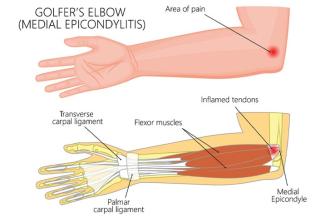
Get Rid of Golfer's Elbow for Good!
Golfer’s elbow is a term used to describe pain along the inside portion or medial side of the elbow. Also known as medial epicondylitis/epicondylalgia, this condition causes pain and dysfunction in many populations of people. This injury involves the flexor tendons of the wrist where they originate at the medial epicondyle of the distal (or end portion) of the humerus. The flexor muscles extend down the forearm and allow you to pull your wrist and/or fingers toward the palm side of the hand. Golfer’s elbow typically arises due to overuse, repetitive movements or excessive gripping from occupational or domestic demands which causes inflammation and pain at the medial elbow. Occupations most at risk are carpenters and plumbers. Medial epicondylalgia is also commonly seen in overhead athletes such as baseball players. Another cause of golfer’s elbow is thought to be caused by weakness of the shoulder girdle. Shoulder weakness, commonly the rotator cuff and scapular stabilizers, may lead to compensation by the forearm muscles leading to repetitive overuse strain.This pain can be quite debilitating and cause difficulties with work or sport participation and daily activities such as gripping objects, opening a jar, turning a door knob or working out.
People with golfer’s elbow may complain of several symptoms including pain at the indie of the elbow during hand/wrist/finger movements, numbness that extends from the inside of the elbow down to the hand or fingers when gripping objects, tenderness of the bone on the inside of the elbow, grip weakness and/or elbow stiffness.
Research has driven recent trends of treating golfer’s elbow conservatively. Research has shown physical therapy to be more effective in the long term compared to injections, pain medication and surgery. A physical therapist is trained to assess and treat golfer’s elbow and is able to explain the injury and how to go about treating it. As this condition typically is a result of stress over time, rehab can unfortunately be a slow process sometimes.
When seeking the care of a physical therapist, you will be taken through a full examination of shoulder, elbow and wrist ROM and strength, grip strength and cervical spine screen to clear any involvement from the neck. Your PT will also inquire about your specific job duties, recreational activities (if any), assess your posture, and perform an ergonomics assessment if possible. Once this data is obtained, your PT will for a rehab plan for your specific needs. Treatment for golfer’s elbow typically involves:
- Shoulder strengthening exercises (rotator cuff and scapular stabilizers)
- Elbow and wrist range of motion exercises
- Stretching exercises for wrist flexors
- Strengthening of the forearm flexors (emphasis on eccentric strengthening)
- Manual therapy including joint and spine manipulation, soft tissue mobilization
- Taping (kinesiotape, KT tape, RockTape, etc.)
- Pain modulation with ice or heat
- Use of electrotherapy (TENS or IFC)
If you or a loved one are suffering from the debilitating effects of golfer's elbow, please contact your local Doctor of Physical Therapy. As mentioned earlier, this is often a chronic condition that may take some time to subside but your PT will get you well on your way to living a pain-free life. Physical therapists improve the way you move!

